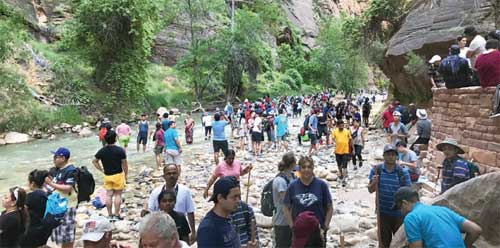By Brice Wallace
If national parks are a fair gauge of tourism economies, COVID-19 brought a roaring freight train to a screeching halt in Utah.
Statistics released recently by the U.S. Department of the Interior indicate that 2019 in Utah was a record year across the board for national park visitation, visitor spending, jobs, labor income, value added and economic output.
The report pegged economic output at $1.9 billion, up from $1.8 billion in 2018 and up from $861 million in 2012. About 15.3 million people who visited the parks last year spent a total of $1.2 billion, matching 2018’s spending total and up from $614 million in 2012. Parks accounted for 18,900 jobs, up from 18,700 in 2018 and 9,420 in 2012. Labor income reached $614 million, up from $605 million in 2018 and $296 million in 2012. The value-added total was $1.1 billion last year, up from $1 billion in 2018 and $493 million in 2012.
Nationwide, last year’s visitor spending in communities near national parks resulted in a $41.7 billion benefit to the nation’s economy and supported 340,500 jobs. Visitor spending increased by $800 million from 2018 to 2019 and the overall effect on the U.S economy grew by $1.6 billion. In the past five years, visitor spending has increased by $4.1 billion and the effect on the U.S. economy grew by $9.7 billion.
The park service reported more than 327 million visitors in 2019 who spent $21 billion in communities within 60 miles of a park in the National Park System. Of the 340,500 jobs supported by visitor spending, more than 278,000 jobs exist in communities adjacent to parks, it said.
“We have been working to safely welcome the public back to their national parks and provide more service again,” said David L. Bernardt, U.S. secretary of the interior. “These treasured places provide respite and recreation for the American people, in addition to vital economic support to gateway communities across the country.
“The tremendous value of our national parks is undeniable, as is the need to adequately maintain them, which is why President Trump has called on Congress to address the decades of deferred maintenance.”
In Utah last year, Zions National Park led the way, with record-high visitor spending of $258 million, up from $246 million in 2018; record-high jobs of 4,320, up from 4,120 the prior year; labor income of $101 million, up from $95.6 million in 2018 and short of the record of $126 million in 2016; value-added of $177 million, up from $168 million in 2018 and short of the record of $215 million in 2017; and record-high economic output of $344 million, up from $327 million in 2018.
Other Utah national park figures from 2019 include:
• Arches: Park records of $264 million in economic output, up from $263 million in 2018; visitor spending of $201 million, up from $200 million; jobs totaling 3,090, up from 3,080; labor income of $81.9 million, up from $81.4 million; and value-added of $145 million, up from $144 million.
• Bryce Canyon: Economic output of $269 million, down from $275 million in 2018; visitor spending of $222 million, down from $227 million; jobs totaling 3,210, down from 3,290; labor income of $83.4 million, down from $85.2 million; and value-added of $148 million, down from $151 million.
• Capitol Reef: Park-records for economic output of $102 million, up from $101 million in 2018; visitor spending of $89.8 million, up from $89.2 million; jobs totaling 1,190, up from 1,180; labor income of $31.3 million, up from $31 million; and value-added of $56 million, up from $55.5 million.
• Canyonlands: Economic output of $54.8 million, up from $54.5 million in 2018 but short of the record of $57.6 million in 2016; visitor spending of $45.9 million, up from $45.8 million in 2018 but short of the record $47.6 million in 2016; jobs totaling 647, up from 646 in 2018 but down from 722 in 2016; labor income of $17.2 million, up from $17.1 million in the prior year but short of the record of $18.1 million in 2016; and value-added of $30 million, up from $29.9 million in 2018 but short of the high of $32.4 million in 2016.
For comparison, Grand Canyon National Park in Arizona last year attracted nearly 6 million visitors who spent more than $890 million, supporting 11,806 jobs and generating a $1.1 billion total economic output. Grand Portage National Monument in Minnesota recorded roughly 94,985 recreation visitors who spent an estimated $6.2 million. That spending supported 78 jobs and more than a $6 million total economic output.
“Safely increasing access to national parks and other public lands supports individual and collective physical and mental wellness,” said National Park Service Deputy Director David Vela. “It also benefits park gateway communities where millions of visitors each year find a place to sleep and eat, hire outfitters and guides and make use of other local services that help drive a vibrant tourism and outdoor recreation industry.”








